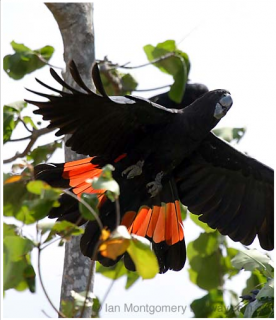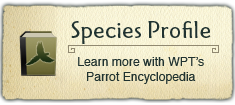Project Regions:
Red-tailed Black Cockatoo |
|
|
Collaborators/Funders
Joseph Forshaw, DCNR (Department of Conservation and Natural Resources), SE Australia
Red-tailed Black Cockatoos affected by loss of feeding and nesting trees
The Red-tailed Black Cockatoo (Calyptorhynchus banksii) has been affected by human pressures.
Project progress: In 1991 author and ornithologist Joe Forshaw suggested that WPT provide funding for a project in South Australia to help protect a remnant population of the graptogyne sub-species of the Red-tailed Black Cockatoo. WPT funded the recording and guarding of these birds for six years, from 1991 to 1997.
Outcomes: The responsibility for the protection of these birds has subsequently been taken over by the State Governments of South Australia and Victoria and continues today. And for the first time, the 2014 Great Cocky Count, conducted through Birdlife Western Australia's Threatened Black Cockatoo Program, also included the Red-tailed Black Cockatoo. In the future Birdlife's volunteers will monitor breeding and feeding ecology of all of the species of black cockatoo in SW Australia.
Wild population: In excess of 100,000; graptogyne only 1000.
Where found: C.b. banksii: NE Australia, including offshore islands, from Gulf of Carpentaria and C Cape York Peninsula, N Queensland, south to SE Queensland and rarely to NE New South Wales.
C.b. macrorhynchus: N Australia from Kimberly division of W Australia east to Gulf of Carpentaria, N Queensland.
C.b. samueli: Coastal and subcoastal mid W Australia; along rivers of central ranges in southern Northern Territory and northern S Australia; Lake Eyre and Bulloo River from SW Queensland to far NE South Australia; along upper to middle reaches of Darling River and its tributaries in W New South Wales.
C.b. graptogyne: SW Victoria and SE South Australia.
C.b. naso: SW Australia north to Darling Range and east to Stirling Ranges.
History: The Red-tailed Black Cockatoo, Calyptorhynchus banksii, is found over most of Australia. It is seen in areas with Eucalyptus trees, usually along river systems, taking seeds, nuts and Eucalyptus fruits for food. As a whole the Red-tailed Black Cockatoo is listed as Least Concern by IUCN, however, some subspecies have been affected by human pressures: subspecies graptogyne is affected by the loss of one species of Eucalyptus for nesting, and another for food, both of which have been cleared for cultivation of crops. Subspecies naso is also in danger from loss of habitat through timber harvesting and agriculture.
Threats:
- Habitat destruction and fragmentation
- Loss of 60% of the original vegetation across southwest Australia to agriculture and natural resource production
- Altered weather patterns reducing regeneration of vegetation
- Nest site competition
- Fire, both natural and human-caused
- Poaching
- Vehicle strikes
- Illegal shooting and persecution
Source: Jessica Lee, Birdlife W Australia, PsittaScene Nov. 2012
Ecology: The Red-tailed Black Cockatoo is found in areas with Eucalyptus trees, usually along river systems. They are nomadic, with seasonal movement in the north, also traveling inland with the wet season. Southern birds move where food is abundant; large flocks gather where they find a lot of food: seeds, nuts, fruits of Eucalypts, and sometimes larvae. Birds create a large amount of leaf, twig and branch litter beneath trees they have fed at and are found in family groups of three within larger flocks of up to 2000 birds.


































